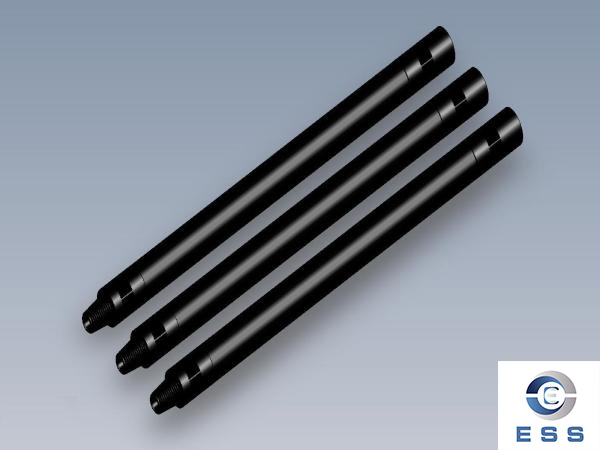Causes and preventive measures of
drill pipe fracture

Overview
Drill pipe fracture refers to the accident of drill pipe fracture during drilling operation. Drill pipe fracture is one of the most common accidents in drilling. It not only affects drilling operations, but also may cause serious casualties and equipment losses. Therefore, it is very important to analyze the causes of drill pipe fracture and formulate preventive measures.
The material of the drill pipe
Mainly depends on its use and working environment. The following are the common types of materials for drill pipes:
Alloy seamless steel pipe, geological alloy steel pipe, high-quality alloy structural steel, drill pipe joints use high-quality alloy structural steel, carbon steel pipe, alloy steel pipe, stainless steel pipe, titanium alloy pipe; The material selection of the drill pipe is not only related to its mechanical properties, but also affects its corrosion resistance, high temperature resistance and lightweight requirements, so as to adapt to different working environments and operating requirements.
Causes of drill pipe fracture
1. Insufficient fracture strength
Insufficient fracture strength of drill pipe is one of the main causes of drill pipe fracture. This may be caused by poor material quality, incorrect manufacturing process or unreasonable design.
2. Fatigue fracture
Fatigue fracture is one of the main causes of drill pipe fracture, because the drill pipe needs to withstand large tensile, bending and torsion forces for a long time during drilling operations. These forces will cause changes and damage to the material properties of the drill pipe, surface cracks and internal fatigue damage to the drill pipe, and eventually lead to fracture.
3. Excessive internal pressure
Environmental factors such as pressure and temperature in the borehole will produce internal stress on the drill pipe. If this pressure is too high, it will cause the drill pipe to deform and break.
4. Failure of drill pipe connection
Failure of drill pipe connection may cause deformation of the entire drilling tool system, thereby aggravating stress concentration and causing drill pipe fracture.
5. Improper operation
If the operator improperly uses and maintains the drilling tool, or uses inappropriate operating methods during construction, the drill pipe will be twisted, lateral load and other abnormal conditions, further causing drill pipe fracture.
6. Material defects
Drill pipes may have material defects during the manufacturing process, and the material and thickness of the drill pipe body are not up to standard, resulting in insufficient strength of the drill pipe during use, which is prone to drill pipe fracture accidents.
7. Excessive wear
Drill pipes need to dig the well wall for a long time during drilling operations, which will cause excessive wear on the surface of the drill pipe and accelerate drill pipe fatigue and fracture.Vibration, bending wear: Geothermal drilling merchants understand that when the drill pipe column reaches the critical speed, the drill pipe will vibrate, which often causes the drill pipe to bend, excessive wear, rapid damage and fatigue failure. In particular, it is more unfavorable when two types of vibrations (wave node vibration and spring pendulum vibration) of the drill pipe coincide. The critical speed varies with the length of the drill string, the size of the drill string, the size of the drill collar and the size of the wellbore.
8. Tensile failure
Tensile failure often occurs in the process of pulling the stuck drill pipe. When the lifting force exceeds the yield point, a "thin neck" deformation will occur at the weaker part or smaller section of the drill pipe wall. Geothermal drilling merchants say that if the lifting force exceeds the strength just now, the drill pipe will be broken. Tensile failure generally occurs in the upper part of the drill string. Because the upper drill string must bear both pressure and the weight of the drill string.
9. Corrosion
The main corrosive agents that affect drill steel are: oxygen, carbon dioxide, hydrogen sulfide, dissolved salts, acids, etc. Factors affecting the corrosion rate: low mud pH (less than 9.5), temperature, mud flow rate, etc.
How to prevent drill pipe fracture
1. Use high-quality materials: Select high-quality materials to manufacture drill pipes to ensure that the quality meets the requirements and reduce the occurrence of material defects and fatigue fractures.
2. Use the correct process: Ensure that the manufacturing process meets the standards and follows the correct design requirements.
3. Strengthen equipment maintenance: Strengthen the maintenance of drill pipes, regularly check whether the drill pipes and connections have abnormal conditions such as wear and deformation, and replace the parts with serious wear and material defects in time to reduce the occurrence of drill pipe fractures.
4. Proper operation: Strengthen the training of drill pipe use, and operators should follow the correct use and maintenance methods to avoid unnecessary damage and danger.
5. Strengthen personnel training:Strengthen the safety awareness of drilling operators, regularly train operating skills, and avoid improper operation leading to drill pipe fractures.
6. Control drilling parameters:By controlling drilling parameters, reduce the occurrence of excessive wear of drill pipes and ensure the service life of drill pipes.
Summary
The fracture of drill pipes has a serious impact on oil drilling work. In order to reduce the risk of drill pipe fracture, it is necessary to analyze and solve it from multiple aspects. It is of great significance to strengthen the safety management of using high-quality materials and processes in drilling operations, regularly inspect equipment maintenance and strengthen personnel training, optimize the management of various links such as drilling parameter control and proper operation, reduce the risk of drill tool fracture, and improve the efficiency and safety of drilling work.













 Eastern Steel Manufacturing Co.,Ltd not only improve product production and sales services, but also provide additional value-added services. As long as you need, we can complete your specific needs together.
Eastern Steel Manufacturing Co.,Ltd not only improve product production and sales services, but also provide additional value-added services. As long as you need, we can complete your specific needs together.










